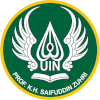KIAI: FIGUR ELITE PESANTREN
DOI:
https://doi.org/10.24090/ibda.v12i2.442Keywords:
Pesantren, Kiai, Islam, Kerajaan Kecil, MasyarakatAbstract
In a pesantren (Islamic boarding school), kiai is an strategic element. Javanese kiai mainly believe that a pesantren is a small palace where he becomes the ultimate source of power and authority. Even though he lives in a rural village, he becomes a member of elite group in social, politic and economic sides in the society. Kiai who leads big pesantren has successfully enlarged their power in term of nation so kiai could be accepted in national elite. The position of kiai is higher among all pesantren elements. The degree as an Islamic scholar is exactly a sacred degree in pesantren culture and tradition. Without his figure, it is impossible for a pesantren to develop and survive. Kiai holds an ultimate position on educate the behavior and morality of the santri (students) to be qualified and compatible Muslims generation. Kiai is not only a leader but he is also the man behind the leadership itself in supporting the progress of Islamic education institution for Muslims generations.Downloads
Download data is not yet available.
References
Abdurrahman Wahid. 1987. Principle of Pesantren Education, The Impact of Pesantren in Education and Community Development in Indonesia. Berlin: Technical University Berlin.
________. 1997. “Pengantar†dalam Greg Fealy & Greg Barton (Ed.), Tradisionalisme Radikal Persinggungan Pesantren-Kiai Langgar di Jawa. Yogyakarta: LKiS.
________. 1998. “Pesantren Sebagai Subkultur†dalam Pesantren dan Perubahan. Jakarta: LP3ES.
Dhofier, Zamakhsyari. 1994. Tradisi Pesantren: Studi tentang Pandangan Hidup Kiai. Jakarta: LP3ES.
Farchan, Hamdan & Syarifuddin. 2005. Titik Tengkar Pesantren: Resolusi Konflik Masyarakat Pesantren. Yogyakarta: Pilar Media.
Geertz, Clifford. 1989. Abangan, Santri, Priyayi dalam Masyarakat Jawa. Surabaya: Pustaka Jaya.
________. 1960. The Javanese Kijaji:The Changing Role of a Cultural Broker, “Comparative Studies on Society and History, vol. 2. Cambridge. Jary, David & Jary, Julia. 1991. Collins Dictionary of Sosiology. New York: Haper Collins Publisher.
Katodirdjo, Sartono (Ed.). 1988. Elite dalam Perspektif Sejarah. Jakarta: LP3ES.
Keller, Suzana. 1997. Penguasa dan Kelompok Elite. Jakarta: PT Rajawali Press.
Madjid, Nurcholish. 1997. Bilik-Bilik Pesantren: Potret Sebuah Perjalanan. Jakarta: Paramadina.
Rahardjo, M. Dawam. 1985. Pesantren dan Pembaharuan. Jakarta: LP3ES.
Ritzer, George. 1995. Sosiology Theory. New York: Mc Graw Hill.
Sukamto. 1999. Kepemimpinan Kiai dalam Pesantren. Jakarta: PT Pustaka LP3ES.
Turmudi, Endang. 2004. Struggling for Ulama: Changing Leadership Roles of Kiai in Jombang East Java, ter. Supriyanto Abdi (Perselingkuhan Kiai dan Kekuasaan). Yogyakarta: LKiS
Usman, Sunyoto. 1998. Pembangunan dan Pemberdayaan Masyarakat. Yogyakarta: Pustaka Pelajar.
Yusuf, Choirul & Suwito NS. 2009. Model Pengembangan Ekonomi Pesantren. Purwokerto: STAIN Press.
________. 1997. “Pengantar†dalam Greg Fealy & Greg Barton (Ed.), Tradisionalisme Radikal Persinggungan Pesantren-Kiai Langgar di Jawa. Yogyakarta: LKiS.
________. 1998. “Pesantren Sebagai Subkultur†dalam Pesantren dan Perubahan. Jakarta: LP3ES.
Dhofier, Zamakhsyari. 1994. Tradisi Pesantren: Studi tentang Pandangan Hidup Kiai. Jakarta: LP3ES.
Farchan, Hamdan & Syarifuddin. 2005. Titik Tengkar Pesantren: Resolusi Konflik Masyarakat Pesantren. Yogyakarta: Pilar Media.
Geertz, Clifford. 1989. Abangan, Santri, Priyayi dalam Masyarakat Jawa. Surabaya: Pustaka Jaya.
________. 1960. The Javanese Kijaji:The Changing Role of a Cultural Broker, “Comparative Studies on Society and History, vol. 2. Cambridge. Jary, David & Jary, Julia. 1991. Collins Dictionary of Sosiology. New York: Haper Collins Publisher.
Katodirdjo, Sartono (Ed.). 1988. Elite dalam Perspektif Sejarah. Jakarta: LP3ES.
Keller, Suzana. 1997. Penguasa dan Kelompok Elite. Jakarta: PT Rajawali Press.
Madjid, Nurcholish. 1997. Bilik-Bilik Pesantren: Potret Sebuah Perjalanan. Jakarta: Paramadina.
Rahardjo, M. Dawam. 1985. Pesantren dan Pembaharuan. Jakarta: LP3ES.
Ritzer, George. 1995. Sosiology Theory. New York: Mc Graw Hill.
Sukamto. 1999. Kepemimpinan Kiai dalam Pesantren. Jakarta: PT Pustaka LP3ES.
Turmudi, Endang. 2004. Struggling for Ulama: Changing Leadership Roles of Kiai in Jombang East Java, ter. Supriyanto Abdi (Perselingkuhan Kiai dan Kekuasaan). Yogyakarta: LKiS
Usman, Sunyoto. 1998. Pembangunan dan Pemberdayaan Masyarakat. Yogyakarta: Pustaka Pelajar.
Yusuf, Choirul & Suwito NS. 2009. Model Pengembangan Ekonomi Pesantren. Purwokerto: STAIN Press.
Downloads
How to Cite
Ilahi, M. T. (2014). KIAI: FIGUR ELITE PESANTREN. IBDA` : Jurnal Kajian Islam Dan Budaya, 12(2), 137–148. https://doi.org/10.24090/ibda.v12i2.442
Issue
Section
Articles
License
Authors who publish with this journal agree to the following terms:
- Authors retain copyright and grant the journal right of first publication with the work simultaneously licensed under a Creative Commons Attribution-ShareAlike License a that allows others to share the work with an acknowledgement of the work's authorship and initial publication in this journal.
- Authors are able to enter into separate, additional contractual arrangements for the non-exclusive distribution of the journal's published version of the work (e.g., post it to an institutional repository or publish it in a book), with an acknowledgment of its initial publication in this journal.
- Authors are permitted and encouraged to post their work online (e.g., in institutional repositories or on their website) before and during the submission process, as it can lead to productive exchanges, as well as earlier and greater citation of published work (See The Effect of Open Access).

















